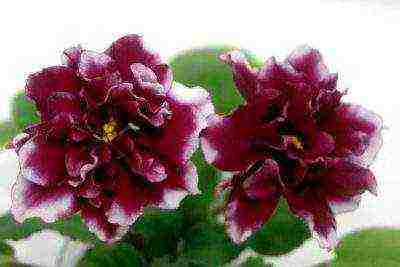Content
- 1 Bubble plant
- 2 Amur bubble
- 3 Features of the vesicle
- 4 Planting the bladder in open ground
- 5 Bladder care
- 6 Reproduction of the bladder
- 7 Bubbles in winter
- 8 Types and varieties of bladderworm with photos and names
- 9 Types and varieties
- 10 Varieties of viburnum bladder
- 11 Reproduction
- 12 Landing
- 13 Care
- 14 Transplant and pruning
- 15 Application in landscape design
- 16 Where can I buy?
- 17 What does a bush bush look like?
- 18 Types and varieties of bladderworm: photo and description
- 19 How to propagate the vesicle by cuttings, layering and division
- 20 How to plant a bladderworm and how to care for it
- 21 How to prune a bladder shrub
- 22 Bubble plant in garden landscaping (with photo)
Surely everyone, at least once in his life, has met this spectacular and at the same time delicate shrub with the funny name "bubblegum". A description of the varieties of this plant is in our material.
About 14 species of this ornamental deciduous shrub are known. The genus Bubble plant (Physocarpus) has been cultivated in our latitudes since 1793 (the first mention in the catalogs of the St. Petersburg Botanical Garden). Nowadays, lush bushes of different varieties of bubblegum can be found not only in the gardens of personal plots, but also in city parks.
It is an unpretentious, frost-resistant shrub. Often the bladder is used as a hedge, planting bushes along railways.
Bubble plant
The bush of the viburnum bladder can reach 3 m in height and the same in diameter. Spreading branches, hemispherical crown, dense. The diameter of the flowers is up to 1.2 cm, the color of the petals is white or pink (mixed shades are possible). Leaves with jagged edges are characterized by a spectacular color: from golden to dark purple. The species has been known since 1864.
Shade-tolerant species, but in order to maintain the color of leaves and flowers, it needs a sufficient amount of sunlight. In regions with severe winters, the bladder must be covered for the winter.
Dart's Gold
A spectacular shrub with decorative bright yellow leaves, delicate flowers and fruits adorns the site throughout the season.
|
|
|||
| Color of petals | Bush height (cm) | Bush width (cm) | Flowering time |
| Pinkish white | 150 | 150 | June July |
Luteus
The Luteus cultivar is perfect for decorating hedges, looks good in contrasting plantings due to the foliage painted in yellow-orange colors.
|
|
|||
| Color of petals | Bush height (cm) | Bush width (cm) | Flowering time |
| White | 300 | 300 | June July |
Red Baron
These varieties are ideal for single and multilevel plantings. The hemispherical crown with pale pink inflorescences and dark red foliage perfectly complements the hedge.
| Color of petals | Bush height (cm) | Bush width (cm) | Flowering time |
| Pale pink | 200 | 200 | June July |
Diabolo
Bubbles Diablo (Diabolo) fascinates with a rich dark purple shade of foliage. It attracts attention both in solitary planting and in hedges.
|
|
|||
| Color of petals | Bush height (cm) | Bush width (cm) | Flowering time |
| Pale pink | 300 | 300 | June July |
Summer Wine
The color of the leaves of the Summer Vine bubblegum is reminiscent of the color of red wine. In the shade, the foliage may turn slightly green, but this does not reduce the decorative effect of the bush.
|
|
|||
| Color of petals | Bush height (cm) | Bush width (cm) | Flowering time |
| Pink and white | 200 | 200 | June July |
Lady in Red
Bubble garden Lady in Red is a relatively new variety. Spectacular wrinkled leaves have a red, up to beet, shade.
| Color of petals | Bush height (cm) | Bush width (cm) | Flowering time |
| White-pink | 150 | 120 | June |
Little Devil
The maroon bushes of this variety can serve as bright spots in contrasting compositions. Little Devil differs in unpretentiousness and durability.
| Color of petals | Bush height (cm) | Bush width (cm) | Flowering time |
| Pale pink | 100 | 100 | June July |
Little Angel
Little Angel Bubble Leaves very small with a burgundy tint. The bush is compact, low, looks good in container plantings.
| Color of petals | Bush height (cm) | Bush width (cm) | Flowering time |
| Pinkish white | 100 | 100 | June July |
Little Joker
This shrub with cherry-colored foliage tolerates frost well. Like other low-growing varieties of bladderwort, it is suitable for growing in containers.
| Color of petals | Bush height (cm) | Bush width (cm) | Flowering time |
| Pinkish white | 90-100 | 100 | June |
Amur bubble
The height of the shrubs of this species reaches 3 m in height. The wide spreading crown has a spherical shape. The leaves are usually dark green in color, the flowers are white (up to 1.5 cm in diameter). The Amur bubble plant in landscape design is traditionally used in group and single plantings. Not inferior to Kalinolistny in unpretentiousness and winter hardiness.
Aureomarginata (Aureomarginata)
The golden-dark border on the green leaves of this variety gives the shrub a charm. The original look of the bush refreshes the garden and attracts attention.
| Color of petals | Bush height (cm) | Bush width (cm) | Flowering time |
| White | 250 | 200 | June |
Nana
This is a low-growing variety of the Amur bladder. The dark green leaves form a compact crown. It is used in complex compositions and in solitary plantings in small areas.
| Color of petals | Bush height (cm) | Bush width (cm) | Flowering time |
| White-pink | 100-120 | 100-120 | June |
If you are looking for beautiful and unusual ornamental shrubs, pay attention to the Snowberry
The deciduous shrub (Physocarpus) is a member of the rose family. The Latin name of such a plant consists of 2 roots of the ancient Greek language, namely: "physo" - "bubble" and "carpos" - "fruit". There are 14 species in this genus. In the wild, the vesicle can be found in North America and East Asia. When grown in a garden, this shrub is distinguished by its unpretentiousness, as well as the fact that it is able to maintain its spectacular appearance throughout the entire growing season. Also, this shrub is fast-growing and resistant to air pollution. Such a plant is grown as a single plant and is used in landscape design. However, the hedge from the bladderwort looks most impressive.
Features of the vesicle
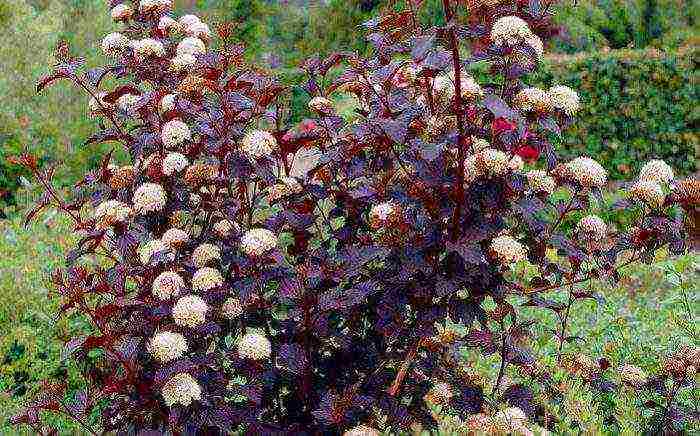
The sprawling bush of the bush consists of drooping branches that form a lush spherical crown. In an adult shrub, peeling of the bark occurs, and in wide strips. In height, it can reach 300 centimeters. Three to five-lobed leaf plates in shape resemble viburnum leaves. Simple white flowers have many stamens. They are part of hemispherical inflorescences, which can reach 5-7 centimeters in diameter. Lush bloom occurs early in the summer.The fruits of such a plant also look quite impressive, they are swollen leaflets that, when ripe, turn red. Only 2 types of vesicle are cultivated, while there are several spectacular varieties, the leaf plates of which have different colors.
Planting the bladder in open ground

What time to plant
If you managed to buy seedlings with a closed root system in a nursery or garden center, they can be planted in open soil at any time of the year (but not in winter). If the purchased seedlings have an open root system, then for planting them, you should choose spring, and best of all, autumn. For planting such a plant, a well-lit, open place is suitable, next to which large trees will not grow. In the event that the variety has a green leaf color, then such a shrub can grow normally in a shaded area. The vesicle is not picky about the soil, however, it must be well-drained, and lime must be included in its composition. If you want it to have the most decorative look, then you should choose a loose loamy soil saturated with nutrients.
How to plant
When preparing the planting hole, it should be remembered that its size should be such that a layer of soil saturated with nutrients (or an earth mixture consisting of peat, turf, earth and sand) can fit in it, while the root collar of the seedling after planting should be flush with the surface of the site. In this regard, it is recommended to prepare a hole by digging it and filling it with fertile soil half a month before the planned planting day, in this case the soil will have time to settle well. The seedling is placed in the planting hole together with an earthen lump, while remember that fertilization should not be applied to the soil during planting, since the young plant is simply not able to assimilate it normally. Then the hole will need to be filled with soil mixture (the composition is described above) or soil saturated with nutrients. The planted shrub needs abundant watering. If after watering the earth settles, then you will need to add it. The first days should be monitored so that the near-stem circle of the vesicle is constantly slightly damp. The surface of the site should be covered with a layer of mulch (humus or peat).
Bladder care
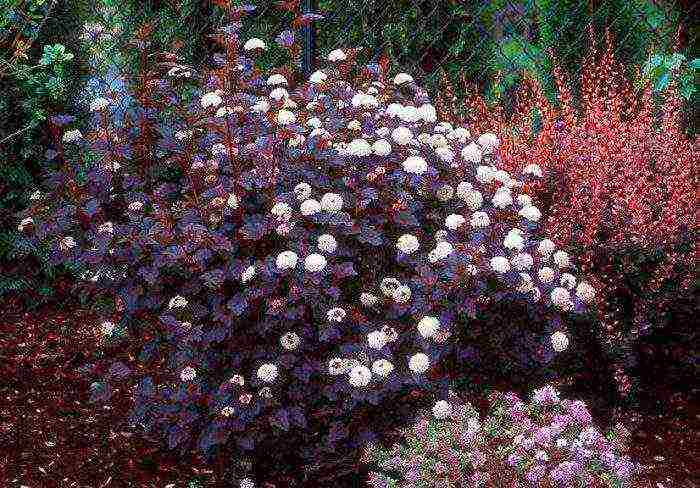
When caring for such a plant, it is very important to water it on time, as it reacts extremely negatively to drought. When watering, make sure that the liquid does not get on the surface of the leaf plates and inflorescences, as this can lead to burns. In this regard, this procedure is recommended to be performed early in the morning or in the evening. In the summer, during the hot period, watering will need to be carried out about a couple of times a week, while at the same time 4 buckets of water should go to 1 bush. Observe the state of the bladder leaves, because not only drought, but also waterlogging of the soil can harm it. In the event that the site is not covered with mulch, then every time after the shrub is watered, it is necessary to loosen its surface and weed.
You need to feed the plant a couple of times a year (in spring and autumn). In spring, the plant should be fed with the following nutrient mixture: for 1 bucket of water, take a five-hundred-gram can of mullein, as well as 1 large spoonful of urea and ammonium nitrate. For 1 adult bush, 1.5 buckets of such a solution are taken. In autumn, one and a half buckets of nutrient solution should be poured under each bush, consisting of 10 liters of water and 2 large spoons of nitroammophoska.
Pruning
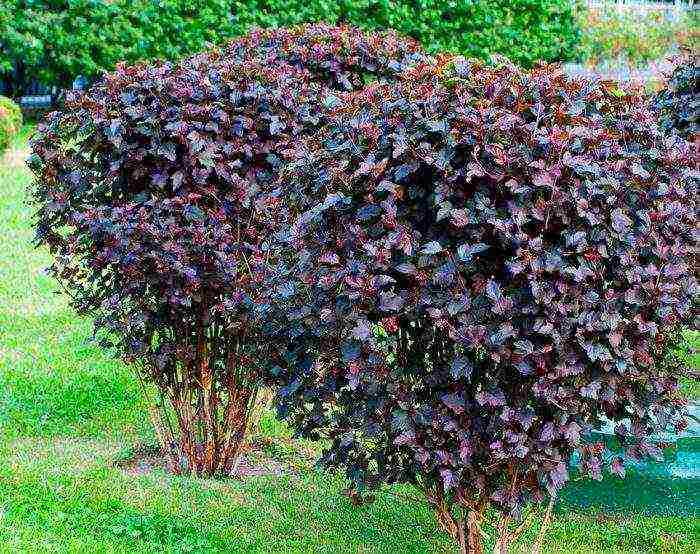
This shrub needs systematic sanitary and formative pruning.In spring, it is imperative to prune for sanitary purposes; for this, all injured, diseased, frost-affected stems and branches, as well as those that grow inside the bush, are cut off. By pruning the vesicle in the fall, you prepare it for the coming winter. Pruning to form a crown can be done in the fall, but experienced gardeners recommend doing it in the spring. In order for the bush to have the shape of a fountain, you need to cut off all the thin stems at the base, leaving 5 or 6 of the most powerful ones, which must be shortened a little. If you want the bush to be wide, you need to cut it at a height of 50 centimeters. When the shrub is 6 years old, rejuvenating pruning is performed on the stump. On thick stems, the places of the cuts should be smeared with garden var.
Transfer
In some cases, it becomes necessary to transplant this plant, for example, you need to transfer it to another place. If the shrub is already an adult, then it should be transplanted in early spring, before the buds swell, or in the autumn, when leaf fall ends. The bush is transplanted with a sufficiently voluminous earthen clod, while first pruning is done, during which the injured, diseased and thickening stems are cut off, and the remaining ones should be shortened to 0.2-0.3 m. Thanks to this, you will be able to put a load on the root system weaker, because during adaptation it will be extremely difficult for her to feed an adult plant. The transplant is carried out in almost the same way as the planting, only it should be taken into account that the vesicle in this case is already an adult. The transplanted bush must be watered using a solution of Heteroauxin or Kornevin, and you also need to spray the leaf plates with Epin or Ecogel-antistress.
Diseases and pests
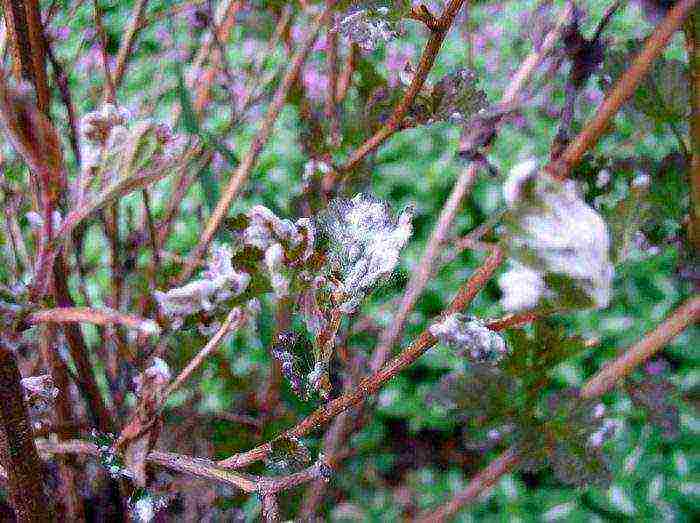
It is quite simple to plant and grow a vesicle, and the gardener will also be pleased that it has a very high resistance to pests and various diseases. However, if the soil does not get nutrients, then the plant develops chlorosis, due to which the apical stems dry out and young leaf plates turn yellow. If you notice signs of this disease, then you should spray the foliage or water the bush itself under the root with a solution of Ferrylene, Antichlorosis, Ferovit, but experienced gardeners recommend using Iron Chelate. As a rule, after this procedure, the vesicle recovers very quickly.
Reproduction of the bladder
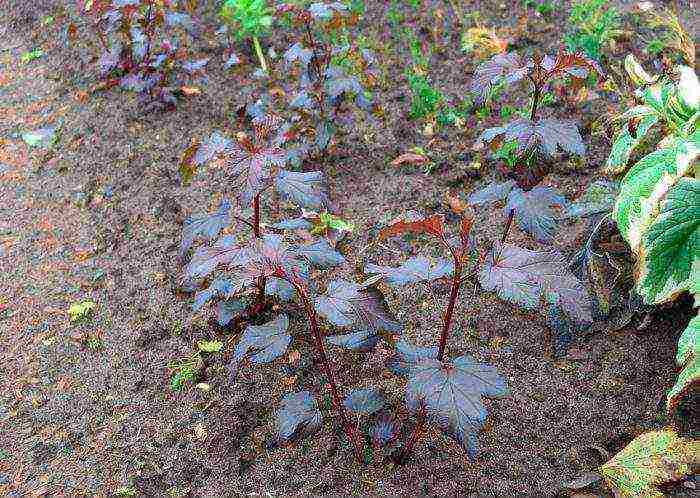
The bladder can be easily propagated in a vegetative way, namely by cuttings, layering, as well as dividing the bush. The generative (seed) method of reproduction is also suitable for this. Seeds are sown in spring or autumn, while first they need to be stratified within 30 days. However, you should be aware that shrubs grown in this way rarely retain the rich color of the leaves, which is inherent in the parent plant. And the cultivation of a vesicle from seeds is a rather laborious process. In this regard, it is recommended to resort to vegetative methods for its reproduction.
Cuttings
Cuttings should be harvested before the bush blooms. To do this, cut off the green shoots of this year. The length of the cuttings can be from 10 to 20 centimeters, and each of them should have 2 or 3 internodes. All leaf plates at the bottom of the cutting must be cut off, and those at the top are shortened by ½ part. Prepared cuttings must be immersed in a solution of a means that stimulates root formation (for example, Kornevin). Then they are planted in a training bed in a mixture of peat and sand. They are watered and covered with polyethylene film. It is very simple to care for the cuttings, they must be watered and systematically ventilated on time.In winter, rooted cuttings need shelter, and in spring they can be planted in a permanent place.
How to propagate by layering

This breeding method is the simplest and most effective. In springtime, the most powerful and absolutely healthy shoot should be selected, which must necessarily grow outward. All leaf plates should be cut off from it, leaving only those growing at the very top. Then this stem is placed in a previously prepared groove, the depth of which should be about 12 centimeters, then it is fixed using a brace made of wood (you can take hairpins for hair), then the groove must be filled with soil. Throughout the growing season, the cuttings will need timely watering, weeding and loosening of the soil surface. By the onset of the autumn period, the cuttings will have to give roots, and it must be separated from the parent bush and covered for the winter.
How to propagate by dividing a bush

By dividing the bush, it is best to propagate the bladderwort. This procedure is performed in spring or autumn. However, if you have experience and certain skills in this matter, then you can divide the bush in the summer. In order for this procedure to end successfully, it must be carried out very quickly, because the root system, which is in the fresh air, should not dry out in any case.
Bubbles in winter
Autumn care
In the autumn period, this shrub looks especially impressive, because it is at this time that the foliage is painted in different colors. It has a relatively high frost resistance and in winter, as a rule, only those branches that have not had time to ripen freeze. But it should be borne in mind that rooted cuttings, like young specimens, need shelter for the winter.
Preparation for wintering
In the event that forecasters foreshadow a very frosty winter, then adult vesicle bushes should also be covered. To do this, you need to carefully pull off the bush with twine, and then "put" on it a cone made of roofing material or loosely wrap it with lutrasil. However, first you need to cover the surface of the trunk circle with a layer of mulch (peat), the thickness of which should be from 5 to 8 centimeters. Young shrubs should be cut off, their trunks should be mulched, and then covered with spruce branches.
Types and varieties of bladderworm with photos and names
At the moment, only 2 species of the vesicle are cultivated, as well as their varieties and varieties.
Amur bubblegum (Physocarpus amurensis)

This species can be found in natural conditions in North Korea, North China and the Far East, while it prefers to grow in mixed forests. The height of such a shrub with a spherical crown is about 300 centimeters. Young stems are brownish-red and smooth, while on old trunks, the bark is peeled off in longitudinal stripes. The three to five lobed leaf plate has a heart-shaped base and is about 10 centimeters long. Their front surface is dark green, and the seamy surface is whitish-gray, because star-shaped felt hairs are located on it. Corymbose inflorescences consist of 10-15 white flowers with one and a half centimeter diameter. Flowering lasts approximately 20 days. The fruit is a swollen leaflet that turns red when ripe. This species is highly frost-resistant. It is used to create hedges, as well as in group and single plantings. Cultivated since 1854 The most popular forms:
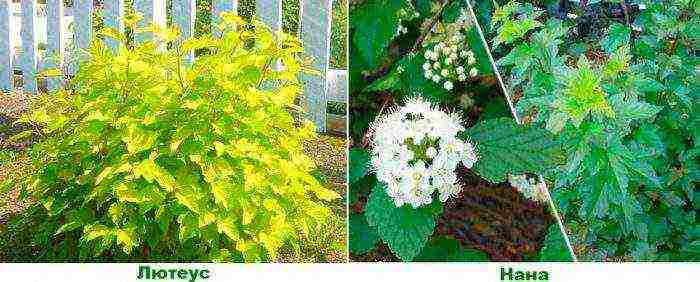
- Luteus... In the summer, the leaf plates are painted in a deep yellow color, and in the autumn they turn bronze.
- Aureomarginate... The leaf blades have a dark golden edging.
- Nana... Such a dwarf shrub has dark green monochromatic leaf plates.
Bubble plant (Physocarpus opulifolius)
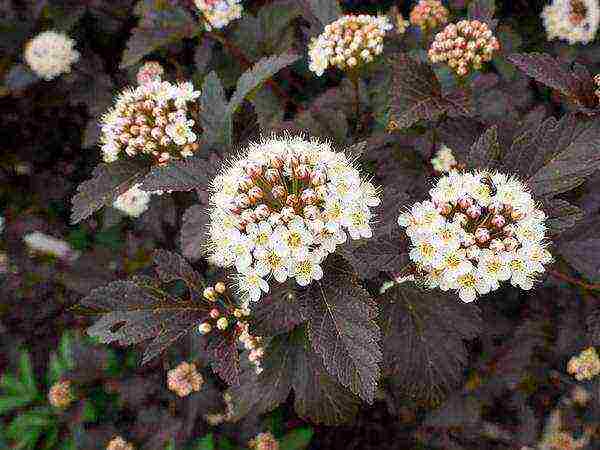
The homeland of this species is the eastern part of North America, while it prefers to grow in undergrowth and on river banks. This shrub with a lush hemispherical crown in height can reach 300 centimeters. Elliptical three to five lobed leaf plates have an elongated large middle lobe and a serrated edge. Their front surface is green, and the seamy side is painted in a paler shade, sometimes it can be pubescent. Small (about 1.2 cm in diameter) flowers have pink or white color, and red stamens. The fruit is a swollen, assembled pale green leaflet that turns red when ripe. This type can be used to create a hedge, as well as in single or group plantings. Cultivated since 1864 The most popular varieties:

- Darts Gold... The height of a dense and wide bush can be up to 150 centimeters. Yellow leaf plates turn greenish-yellow in summer. The racemose inflorescences consist of white or pink flowers.
- Diablo (red-leaved)... The height of the bush is about 300 centimeters. The color of its foliage is purple or dark red. If the bush is grown in a shaded place, then its leaves will be green with a purple tint, and when grown in a sunny place, they have a red color. In autumn, the color of the foliage does not change. This variety is the most popular.
- Red Baron... The height of the bush is about 200 centimeters. The bare oval three-to-five-lobed leaf plates reach 7 centimeters in length and have a serrated edge. They are painted in a spectacular dark red and are narrower than Diablo's vesicle. Umbellate inflorescences consist of white flowers with a pink tint, reaching a diameter of 5 centimeters. The fruits of red color also look quite impressive, which include from 3 to 5 pointed sacs. This variety is among the most valuable.
- Lady in Red... The bush can reach a height of 150 centimeters. This variety was bred by breeders from England. The leaves of a deep red color gradually darken. The color of delicate flowers is white-pink.
Bubbles (Physocarpus) is a deciduous shrub. It belongs to the Pink family. Distribution - North America and East Asia. There are 14 species in the genus. In the wild nature of Russia, only 2 species grow.
This unpretentious plant has spectacular decorative qualities that it does not lose during the entire growing season. Growth rates are fast. It is often used in landscape design.
The spreading branches of the vesicle form a spherical crown. The height does not exceed 3 meters. Its leaves visually resemble viburnum leaves. Simple small white flowers form inflorescences, which are distinguished by abundant and numerous inflorescences. The diameter of the inflorescence can be up to 7 cm.
In culture, only two types of culture are used. Several varietal varieties stand out among them. They are very attractive to florists and landscape designers due to their decorative properties and unpretentiousness.
Types and varieties
Among the species of the vesicle, two types are widespread in the culture of Russia:
Amur vesicle (Physocarpus Amurensis) Is a shrub native to East Asia. Differs in a spherical crown. Its height does not exceed 3 meters. Smooth shoots are brown with a reddish tint. In old bushes, the bark exfoliates in strips of a longitudinal shape. The leaves are three-lobed or five-lobed. The length of the leaves can reach 10 cm. The upper side is dark green, and the bottom is covered with grayish felt hairs.

Amursky
Up to 15 small white flowers form inflorescences. Flowering lasts up to three weeks. This species is frost resistant. Was cultivated in the second half of the 19th century.It is used for group and solo plantings, and is also common for creating hedges.
Kalinolistny (Physocarpus opulifolius) - a very popular shrub in Russian gardens. This is an unpretentious and very ornamental plant. Differs in special splendor due to the spreading branches that form a crown in the shape of a ball. Corrugated leaves are large in size. The height of the bush is about 3 meters. Small flowers have reddish or pink stamens. They form inflorescences. The leaves can also be three-lobed or five-lobed.
This type of vesicle is very widely used in floriculture and landscape design. Ideal for creating hedges. It became widespread in the culture of Russia in the second half of the 19th century.
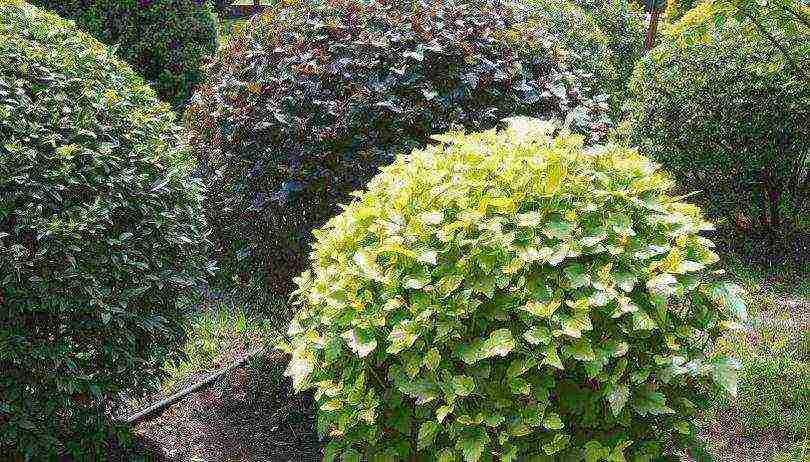
Kalinolistny
Varieties of viburnum bladder
Golden Nugget- a popular variety in floriculture. Very decorative due to its bright golden foliage. Its height usually does not exceed 2.5 meters. The crown is wide and spherical. Flowers are white or pinkish in color. Flowering usually begins in June. This varietal variety is distinguished by undemanding soil, drought resistance and frost resistance. The plant does not tolerate excess moisture and stagnant water. The Golden Nugget is great in a variety of floral arrangements, landscaping and hedging.
Red Baron differs in spectacular decorative properties. The variety is very popular due to its dark red color of the leaves. The height is about 2 meters. Has a spherical crown. In the shade, the leaves are not as red as in the sun, and in the autumn they turn bronze. The growth is fast. The variety is soil-resistant, drought-resistant and winter-hardy. Loves the sun. It is used in bright floral arrangements, as well as in the creation of hedges. It is often used in landscaping cities and gardens.

Red Baron
Diablo - another red cultivar of the bladder (it can be seen in the title photo). The color of the leaves is more intense than that of the Red Baron. The height can be up to 3 meters. The dense and dense crown has a hemispherical shape. Pinkish flowers are collected in corymbose inflorescences. Flowering begins in mid-June. The foliage is red with a purple tint. If the shrub grows in the shade, then the color of the foliage is not so red and saturated. The variety is decorative and unpretentious. Diablo is ideal for landscaping cities and gardens, as well as great for creating hedges that are vibrant and dense.
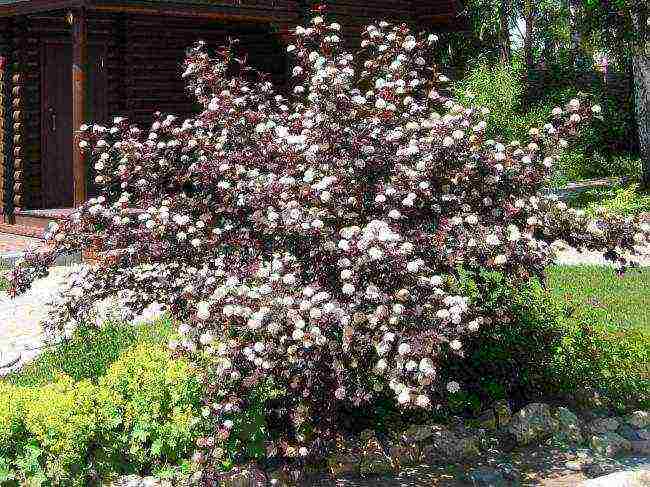
Diablo
Lady In Red Is a spectacular ornamental variety that originated in the UK. Reddish-brown shoots grow upward. The foliage is bright red. Small pinkish flowers are collected in lush dense inflorescences that begin to bloom in June. The shrub grows up to 1.5 meters. This variety is not afraid of winds and drought. Also frost resistant. Lady Ying Red loves the sun. In the shade, its foliage is not so red and saturated.
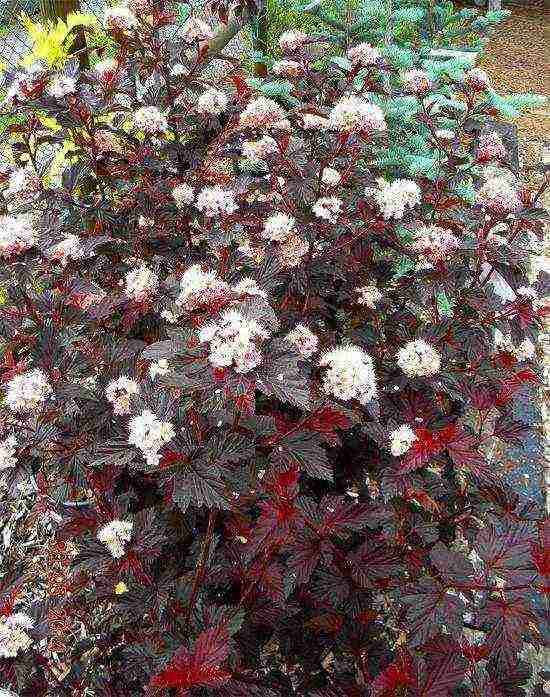
Lady in Red
Summer Wine - two-meter compact shrub. The deep red leaves can turn green in summer, especially if the shrub is growing in the shade. Small white-pink flowers are collected in corymbose inflorescences. Summer vine begins to bloom from late spring. The variety is decorative due to its red-wine foliage and pink inflorescences. This unpretentious and light-loving variety is often used in the creation of hedges and compositions of coniferous and deciduous shrubs and trees, as well as flower beds of perennial flowers.

Summer Vine
Luteus ideal for landscaping parks and gardens. The golden foliage of this shrub cannot go unnoticed. The sunny variety is very unpretentious and not picky about the soil. The bush can be used in a variety of landscape compositions, in decorating buildings and streets. The shape of the crown is hemispherical. The height does not exceed 3 meters.The shrub has numerous white flowers that form shields.
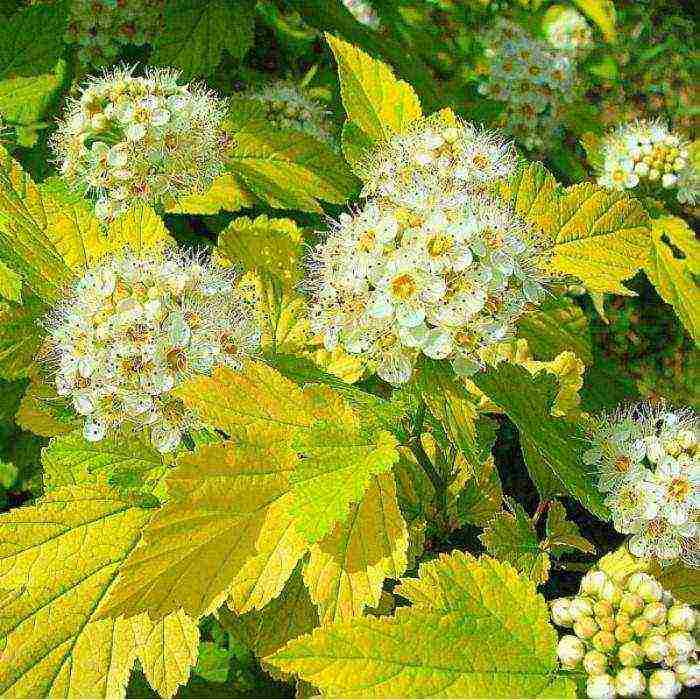
Luteus
Darts Gold (Dart`s Gold) is an improved form of the Luteus variety. The golden bush has numerous white flowers, collected in corymbose inflorescences. Flowering begins in mid-June and lasts for three weeks. This yellow variety loves the sun, but grows in shaded areas, but it loses color saturation. The variety is resistant to drought and light frosts, but does not tolerate stagnant moisture.
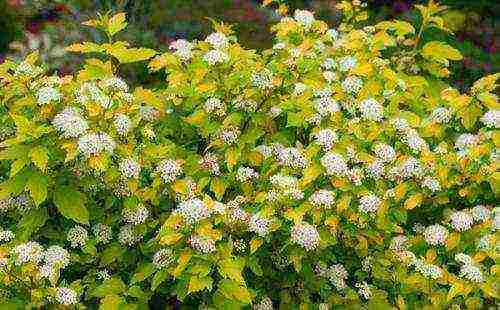
Darts Gold
Aurea - a wonderful shrub, the height of which can reach 2.5 meters. The bright yellow foliage is gorgeous against the backdrop of white inflorescences and reddish fruits. Flowering begins at the end of June. The variety is drought-resistant, winter-hardy and not picky about soils. Can grow in shade, but prefers sunlight. Used in landscaping gardens, creating a variety of compositions and hedges.

Aurea
Little devil - another red-leaved vesicle. The red devil is small in stature (about 1 meter). Shoots grow upward, forming a hemispherical crown. Showers are red with a purple tint. In the shade, the foliage turns green, so it is advisable to plant it in sunny places. The numerous flowers are pale pink in color and form inflorescences that bloom in mid-June. This unpretentious and sun-loving variety is often used to decorate gardens and city alleys and buildings. Also used to create curbs.
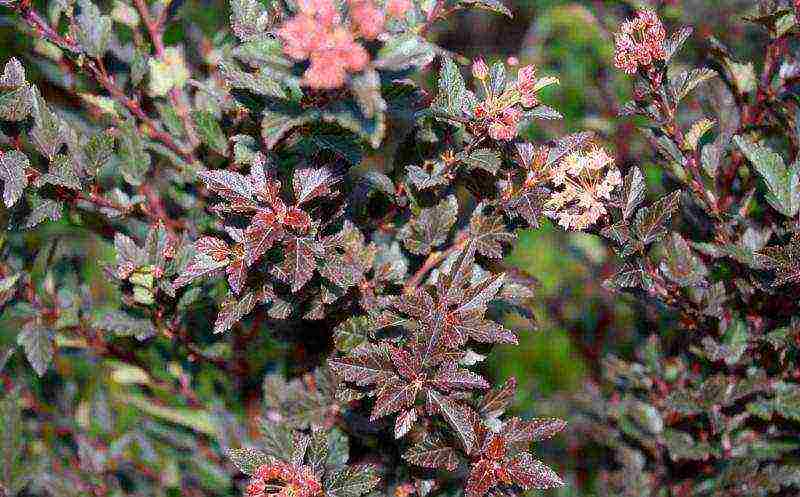
Little Devil
André - This is a cultivar of viburnum bladder with a wide spherical crown. Grows up to 2.5 meters. The foliage is purplish red in color. In autumn it takes on a bronze tint. In early June, spherical inflorescences of small white or pinkish flowers bloom. The variety is resistant to drought, wind and urban conditions. André prefers moist soil and sun. André is great in landscaping gardens and parks, and is also used to create multi-contrast compositions.
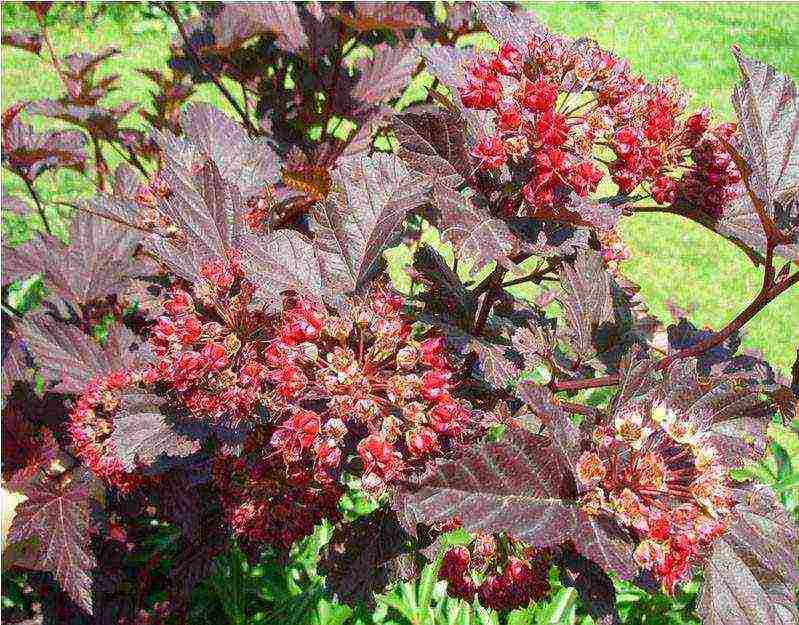
André
Reproduction
The plant is propagated cuttings, layering and dividing the bushes... For propagation by cuttings, it is necessary to use green shoots that have grown this year. Pruning them is required in the spring before the culture begins to bloom. The length of the shoot should not be more than 20 cm. The leaves are removed from the shoot. The leaves are left on top, but shortened a little.
The cuttings must first be soaked in a solution that stimulates root formation. "Kornevin" approaches. For planting, either river sand or a mixture of sand and peat is used. After planting, it is advisable to cover the cuttings with plastic wrap. Bottles with cut necks are also suitable for shelter. Before the onset of winter, the cuttings must be periodically ventilated and moistened.
Rooted shoots must be covered in winter. In spring, they need to be transplanted to a permanent place of growth.
Also the plant reproduces layering... This is relatively simple and effective method... A strong and healthy shoot is used as a layering. All, except for the top, leaves are removed. The shoot is placed in a hole about 15 cm deep and pinned to the ground. This should be done at the beginning of spring, so that during the winter the cuttings can take root in the soil.
In dry times, soil moisture is of great importance. At the end of autumn, young bushes need to be separated from the mother bush and covered for the winter.
Landing
It is undesirable to plant a plant with seeds; it is much better to buy young seedlings with a closed root system. This is due to the fact that when planted with seeds, the original color of the foliage is not transmitted to all offspring.
Bushes can be planted in summer, fall or spring. The hole for planting a seedling should be about half a meter deep and the same diameter. It is advisable to put a little humus or peat substrate at the bottom of the pit. The seedling should not be buried more than 5 cm.After planting, water is required abundantly. It is also advisable to use the Kornevin solution.
The place for planting should be sunny, as in partial shade or in the shade, the color of the leaves becomes less saturated and bright. There should be no lime in the soil, and there should also be good drainage.
For the appearance to be lush and beautiful, the soil must be nutritious, but even on poor soil, the shrub will delight with its flowering. The plant can be planted in the city and next to the highway, since pollution and gas pollution are not terrible for it.
Care
The bladder is distinguished by its unpretentiousness, however, some care rules will still have to be followed. The watering regime depends on the age of the plant, temperature regime and climate. If it is very hot in summer, then it is necessary to water from the end of spring until the onset of the autumn period. Watering should be done at least once a week. A mature tree requires about 40 liters of water. If the soil is heavy loam, then there is a great danger of overflow of the plant.
Excessive moisture can lead to the development of a disease such as powdery mildew. It can cause the plant to die.
In spring and autumn, the culture needs additional feeding. In spring, nitrogen-containing fertilizers act as top dressing, and mineral fertilizers in autumn. In the spring, you can use fertilizer, which consists of:
- 10 liters of water;
- 0.5 liters of mullein;
- 1 tbsp ammonium nitrate;
- 1 tbsp urea.
As an autumn fertilizer, nitroamofoska is diluted (in the size of a matchbox) for 10 liters of water. One adult plant requires approximately 15 liters of fertilizing.
Transplant and pruning
Cropping the crop is essential. There are two types of trimming: sanitary and shaping... The first is carried out in the spring, when the branches are frozen and broken. And in order for the shrub to grow as necessary, it is necessary to carry out formative pruning. It is needed both in spring and autumn. Pruning also promotes accelerated and correct growth of the shoots. To make the bush wide, the shoots are cut off by half a meter. And so that the bush is in the form of a fountain, all thin shoots are cut off at the base, and the remaining shoots are shortened.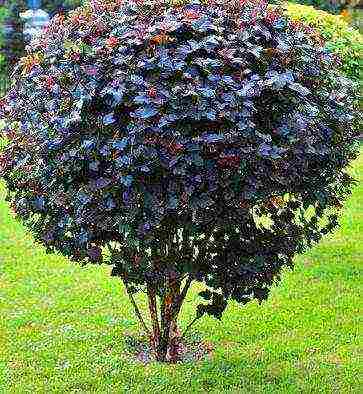
The plant is transplanted if necessary. Before transplanting it, excess and diseased shoots are removed. The transplant is carried out in the spring. The bush is transplanted together with a large earthy clod.
After transplanting, the shrub must be watered abundantly with water and Kornevin solution. It is also necessary to process the foliage. For this, "Epin" is suitable.
Application in landscape design
This decorative culture is immensely popular with the gardener and landscape designers. Its rich colors and numerous blooms will attract the attention of any, even the most sophisticated flower lover.
The bubble plant is used in group and single plantings. It is used in the design of gardens, city parks. They are used to decorate buildings.
But most often the crop is grown to create hedges and curbs.
In the photo above, a hedge of red-leaved, viburnum-leaved vesicles. Such a hedge turns out to be dense, bright and beautiful.
What does the bladderworm combine with?
Golden Luteus will look great with Red Baron and Red Diablo. For Darts Gold, barberry and white turf are ideal.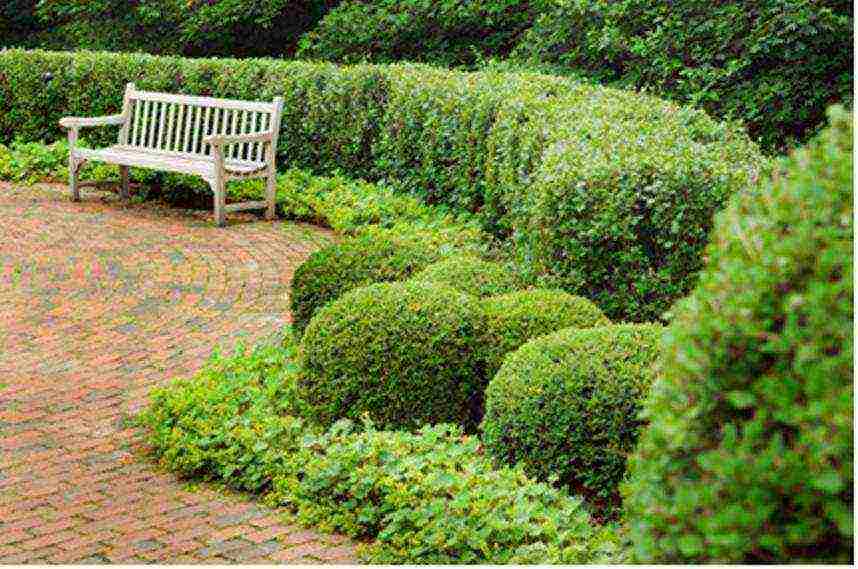
In the photo, different green varieties of the bladder are ideally combined with spirea and barberry for landscaping squares and squares.
Also, the culture looks good in combination with such cultures:
- Chubushnik;
- Kuril tea;
- Honeysuckle;
- Spirea;
- And others.
Dwarf varietal varieties are well suited for planting in flowerpots and pots. These include, for example, Nana. It belongs to the Amur variety of culture. Another undersized variety is Little Devil.

Dwarf green-leaved and red-leaved varieties in pots.
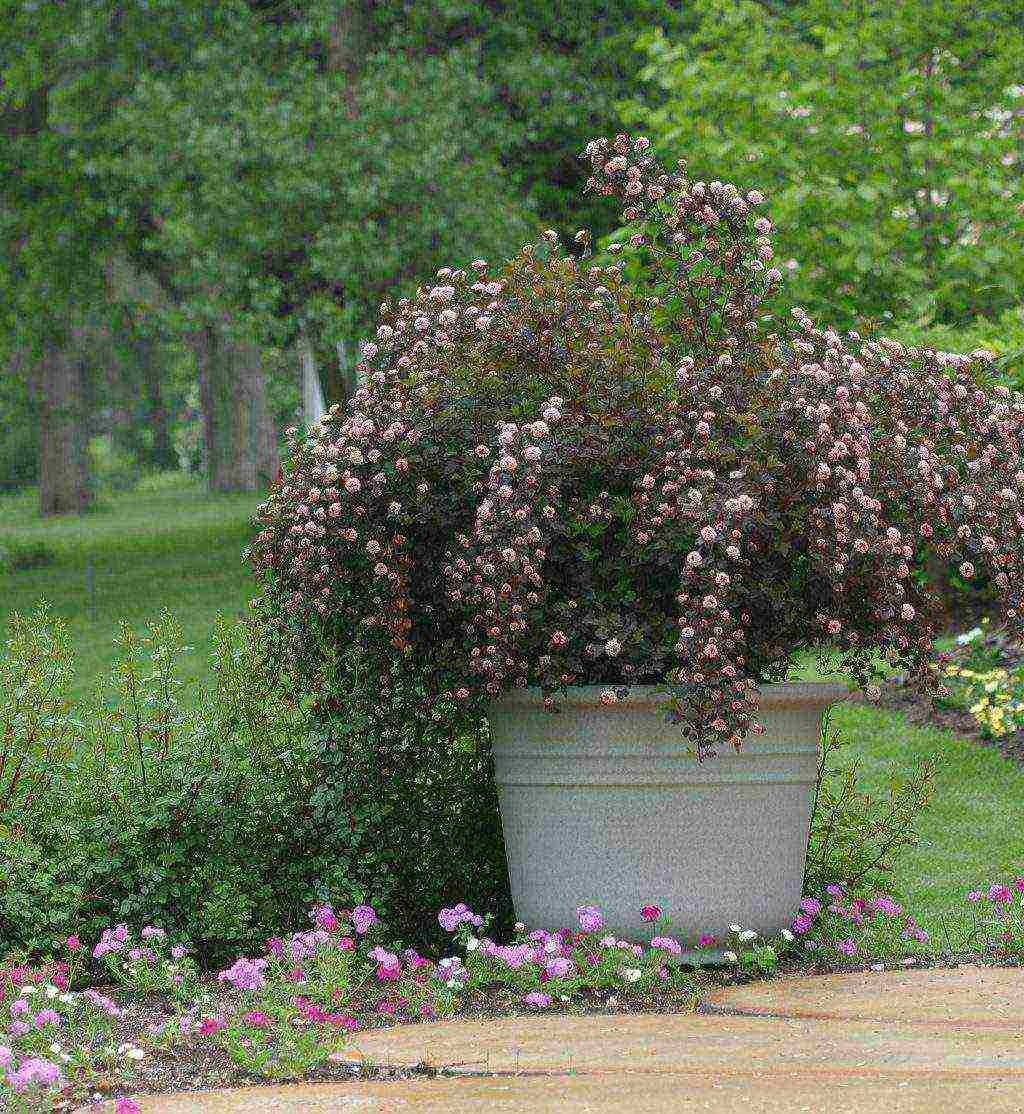
Summer Wine variety
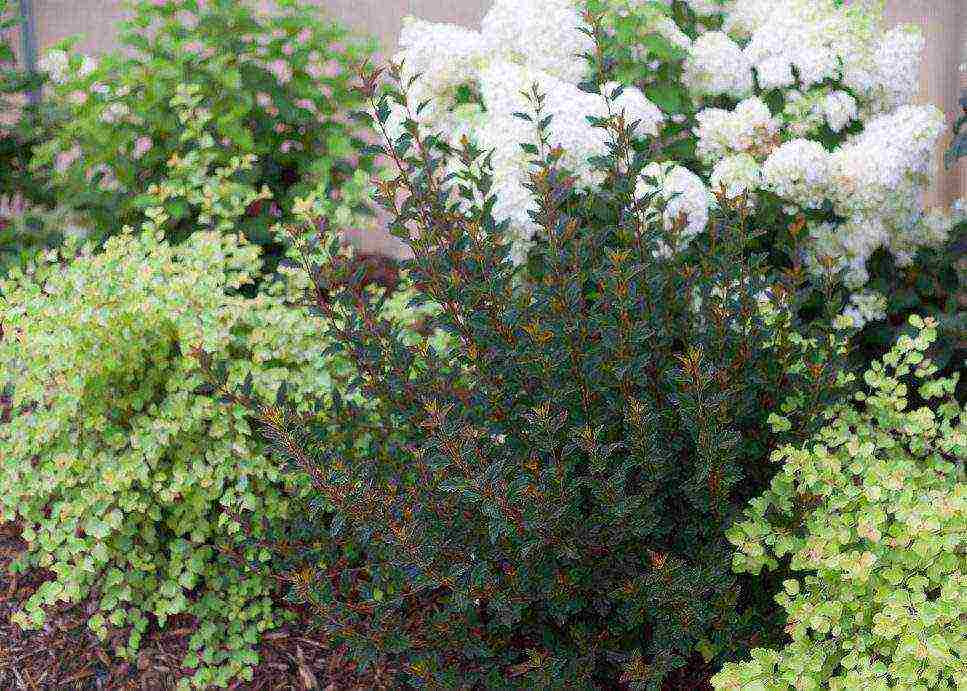
Bubble plant opulifolius Tiny Wine.
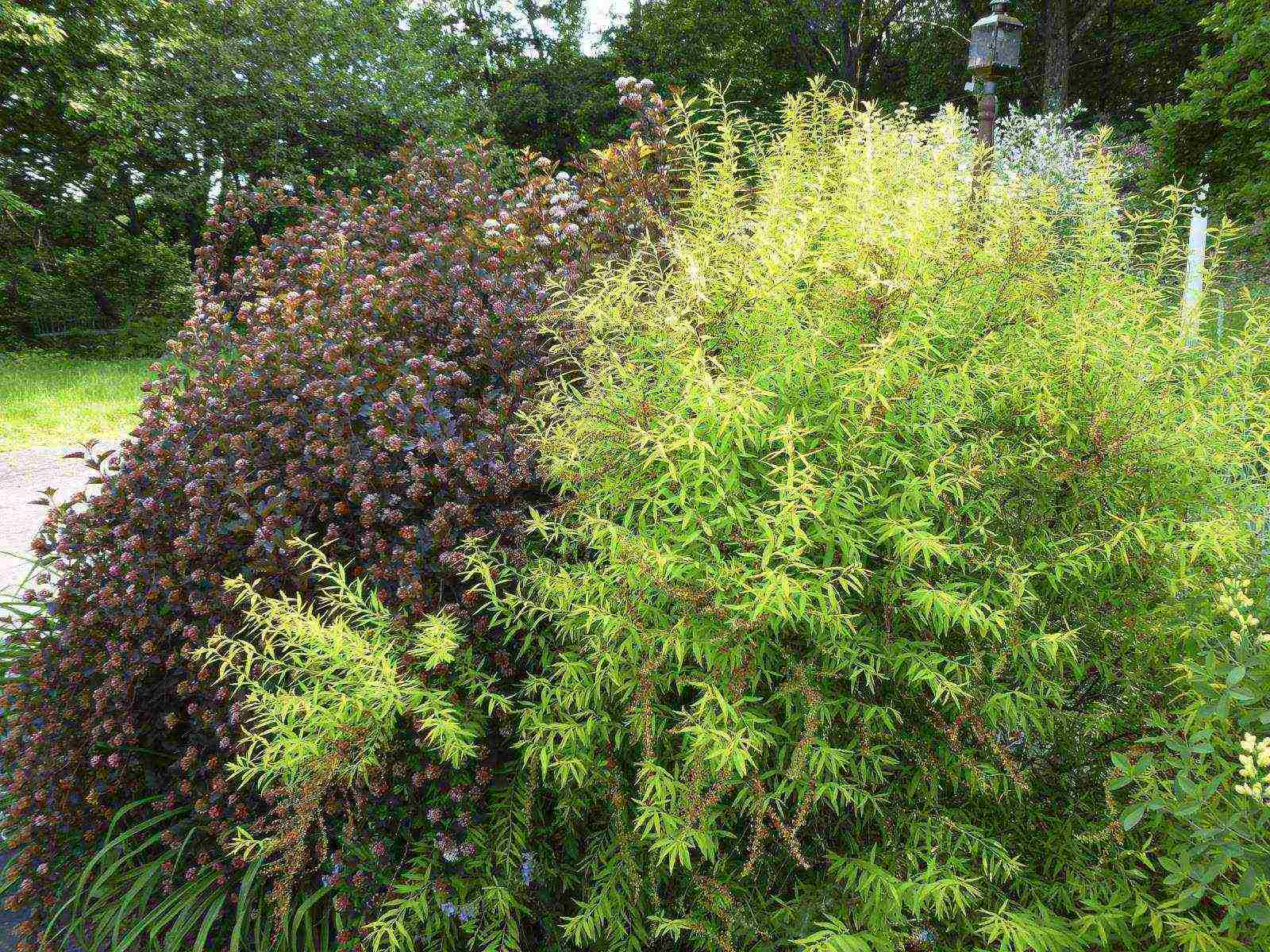
‘Summer Wine’ and ‘Ogon’ spirea

Bubble plant “Diabolo”, peonies, large-leaved hydrangea and hydrangea varieties “Anna Bella”.

Summer wine
Where can I buy?
You can buy saplings of bladderwort in gardening shops, nursery. You can also order by mail and through online stores.
| Variety | Where can I buy | Price |
| Diablo (40-60 cm) | Rosselkhozpitnik in St. Petersburg | 999 p. |
| Luteus (40-60 cm) | Rosselkhozpitnik in St. Petersburg | 999 p. |
| Red Baron (90 cm) | Kennel Kalina (Moscow region) | 450 p. |
Review on video
Consultation from the Florist-X video channel.
The most common type is bladderwort (Physocarpus opulifolius)... This is a bush up to 3 m high with a dense crown. In early summer, the plant is abundantly covered with white or pink flowers, collected in inflorescences. The Luteus form is distinguished by its golden leaf color, which is especially bright at the beginning of the growing season. And the Darts Gold variety retains its golden color all the time. The Aureomarginata form has leaves with a golden border. Diabolo has a dark purple leaf color. The bladder varieties are more compact in comparison with the species plant. There is also a dwarf form Nanus - up to 1 m high.
What does a bush bush look like?
Bubbles are winter-hardy, shade-tolerant, resistant to adverse conditions. He only dislikes stagnant water in the soil. Easily propagated by cuttings. Decorative forms are perfectly combined with each other, thanks to which the bubblegum is used very actively in landscape design. From a species plant, a good hedge is obtained, including a clipped one.
Look at the photo of what a bubblegum looks like, luxuriantly blooming against the background of other plantings:
The appearance of the vesicle depends on its type and variety, but usually it is a shrub with spreading branches that form a spherical crown. The bark exfoliates in wide stripes. The plant reaches a height of up to 2.5 m. The leaves are 3 or 5 lobed, evenly distributed along the branches, which makes the bush look lush from top to bottom. The flowers are white or pinkish, with numerous stamens in the center, grouped in inflorescences (they resemble hemispheres in shape) with a diameter of 5 to 7 cm. The fruits also look impressive, they are swollen, bubble-like leaflets that turn red when ripe. The plant got its name precisely because of the characteristic shape of the fruit.
How well the bladder shrub is combined with other plantings, look at the photo:
To the description of the vesicle can be added to the fact that it grows very quickly, adding up to 40 cm in diameter per season. Its life span is from 30 to 40 years. Among gardeners, it is famous for retaining its decorative appearance for almost the entire season.
After reading the generalized description of the vesicle, look at the photo - it shows what this wonderful representative of the plant world looks like:
Types and varieties of bladderworm: photo and description
Two types of vesicle are considered to be the main ones - Amur and Kalinolistny.
Amurskiy It is located singly or in small groups among thickets of various kinds of bushes, on mountain slopes. It is a protected plant in nature reserves. It is a bush up to 2.5 m tall. On adult specimens, the bark peels off in uniform stripes. The trunks of young bushes are smooth, usually dark in color. Leaves are about 10 cm long, green above and gray below. The flowers are white, about 1.5 cm in diameter, organized in semicircular inflorescences.
Appreciate the beauty of this type of vesicle in the photo presented below:
The Amur vesicles bloom for up to 20 days, the fruits turn red when ripe, giving the shrub a bright, colorful appearance. It is also worth noting that this type of plant tolerates winter well, since the branches are completely lignified. All known forms and varieties of this type of vesicle are actively used in the design of personal plots, parks, city squares.
Vine-leaved species Is a bush about 2.5 m high with wide, spreading branches. Shoots form a dense spherical crown.
We offer you to evaluate the bladder of this species - look at the photo that successfully conveys its advantages:
Leaves are approximately 5 cm in diameter, greenish above, and lighter below, dentate at the edges, slightly drooping.Flowers about 1.2 cm in size, white or pink in color, with villi in the center. The fruits look very elegant, as they ripen, they change their color (from green to red).
Decorative varieties:
Darts gold
Diablo
Red baron
And others serve as an excellent "material" for the work of landscape designers.
You can see the above-described species and varieties of the bladder in the photo, suggested below:
Check out a short description of the varieties of the vesicle (the most famous samples are considered):
Diablo
It grows up to 3-3.5 m in height, up to 2 m in width. The leaves are glossy, in the autumn they change color from deep purple to yellow. At the same time, the shrub looks even more impressive. The flowers are organized in inflorescences, similar in shape to semicircles.
Nanus
Differs in white flowers, small greenish leaves. This dwarf form can reach no more than 1 m. The plant is best planted near hedges, as well as in flower beds - among herbaceous annuals or perennials.
Summer wine
The shrub has medium parameters. The branches with their bend resemble a scattering of fireworks. White-pink flowers are located along the entire length of the branches. The plant blooms in spring. Leaves are deep red. This variety is distinguished by high frost resistance, unpretentiousness to the area.
Luteus
The bushes grow up to 2.5-3 m in height. In the spring there is a yellow color of the foliage, by the summer the crown becomes green. The flowers are snow-white, collected in semicircular inflorescences. The shrub is notable for the fact that its branches form a spherical dome.
Darts gold
The shrub changes the "summer" bright yellow color of its leaves to orange in the autumn. Such seasonal metamorphoses look very original. The flowers of the plant are often white, but sometimes cream color is found.
Red baron
Grows up to 1.5 m in height. This variety differs in corrugated leaves. Flowers are pinkish, they are evenly distributed throughout the bush.
Aureomarginata
A massive specimen with spreading branches. It has an unusual color - green leaves with a dark or golden border.
Nugget
Possesses thick stems directed upwards.
Coppertina
The color is orange in the spring, prone to reddening in the summer. The bush grows up to 2 m.
After reading the description of the varieties of the vesicle, look at the photos that show the most attractive options:
How to propagate the vesicle by cuttings, layering and division
Reproduction of the vesicle is carried out in several traditional ways, namely, using layering, cuttings or dividing the bush.
The following describes the technology of the most popular way of breeding the vesicle - propagation by cuttings:
- Cut off young branches up to 20 cm long, with several branches. In this case, it is necessary to cut off all the leaves from below, and from above to shorten them by about half.
- Soak the cuttings in a root formation stimulator.
- Plant the workpieces in a garden bed, previously supplied with a sand-peat mixture.
- Drizzle abundantly and cover with plastic.
In the future, the cuttings of the vesicle need care: they should be ventilated and watered, and sheltered for the winter. It is not difficult to figure out how to propagate the vesicle by cuttings, even a novice gardener can cope with this.
The cultivation of the vesicle by the method of layering is also not fraught with difficulties. They take a strong shoot, cut off all the foliage from it, except for the top row, put it in a ditch made in advance (depth 10-12 cm). Pinned with a staple, sprinkled with soil. Do not forget about timely watering and weed removal. By the fall, a separate layer will already be ready, with its own root system. It is cut off from the mother shrub, as a result of which a strong sapling of the bladder is obtained, planting and caring for which is further carried out according to general rules.
Next, we will talk about how to propagate the bladder in the garden by dividing the bush.
It is best to start the procedure in early spring or autumn. They dig out a mature bush, cut the root apparatus into several segments, then immediately plant the vesicle (or rather, each new unit obtained in the process of division).
How to plant a bladderworm and how to care for it
Care and cultivation of the vesicle must begin with the selection of the area for planting. The plant feels great both in the sun and in the shade. It is better to choose a site open, without trees nearby. The specimen does not tolerate lime in the soil, stagnant water - this kind of soil will provoke rotting of the root system. The shrub is able to tolerate a high concentration of carbon dioxide, so it is often planted as a hedge near the road.
They purchase a young seedling with closed roots in a proven nursery or use planting material harvested with their own hands. A young plant should not be planted in frosty weather. Planting is better in the fall, as there are more conditions for successful survival, intensive growth.
The following is a step-by-step instruction on how to plant a vesicle:
- Dig a hole, add a layer of fertile soil there a few days before planting so that the soil has time to settle. Determine the depth of the trench in such a way that after placing a layer of fertile soil, the top of the plant roots is on the surface.
- When transferring a seedling to a planting ditch, do not remove the soil from the roots, so as not to harm the immature plant. Fertilizers are usually not added at this stage.
- Fill the trench with a soil mixture (fertile soil layer + sand + turf + peat), water the plant abundantly.
- After the trunk circle has settled, add more earth.
- Watch for several days so that the ground around the seedling does not dry out.
If you want to make a dense hedge out of bladder bushes, plant young plants in 2 strips. Leave a distance of 40 cm between rows, the space between plants within one strip should be 45 cm. In the future, the hedge is formed by pruning for every taste.
Pay attention to how the bubble plant is planted - the photo shows the procedure for transferring seedlings to their stationary "habitat":
How you care for the bladderworm depends on its health and appearance. The plant is unpretentious, but this does not mean that you can forget about it after planting. Under the necessary conditions, a bush can grow up to 40 cm per season. In the second year after planting, flower cobs are only laid, because of this, pruning and accurate crown formation are extremely important. The plant is frost-hardy, but in very cold weather the tops of the branches can freeze over. You should take care of insulation for the winter.
Take a look at the photo - with proper planting and care, the bladder will look just as gorgeous:
The plant does not tolerate drought well. The frequency of moistening is regulated depending on the soil, weather, planting age. If the soil is loamy and the temperature is stable in summer, then the bushes are watered abundantly from mid-spring to early autumn. When watering, the water should not irrigate the leaves or flowers; this causes burns to the shrub. It is recommended to water the plant either before or after sunset. Such manipulations are done 2 times / week. About 40 liters of liquid goes under an adult bush. Avoid stagnant water!
The bladder is famous for the fact that it is practically not susceptible to ailments and parasitic damage. Chlorosis of the leaves is very rare, due to the fact that the plant is deficient in trace elements in the ground. Chlorosis can also be caused by pests that carry viruses. That is why the bushes need to be fertilized regularly. Without proper feeding, they can soon die.
The planting is fertilized twice a year.In the spring, they feed them with nitrogen-containing preparations, nutritious mixtures (10 l of water + 1 tbsp. Of ammonium nitrate + 0.5 l of mullein). Before the onset of cold weather in the fall, fertilize with complexes of minerals.
The plant shows all its decorative qualities only when it receives rational care.
Take a look at the photo - a cared-for bladder really looks amazing:
How to prune a bladder shrub
A sanitary haircut involves the removal of broken, damaged, sick branches. They resort to it in the spring. Formative bladder pruning can be done after flowering. If you want to organize a neat hedge, then you need to cut the plant several times during the growing season. The first haircut is done before bud break. When and how to trim the vesicle further depends on what shape, parameters and direction you want to give it.
Adult bushes also need a rejuvenating haircut (every 6 years). The optimal time for her is early spring, when the period of foliage formation has not yet begun. It is allowed to carry out the procedure in the fall, after the deciduous season. Old, dried branches are removed to their very base, and the rest are cut off until the side shoots originate.
In specimens that grow freely, the crown resembles a fountain. To make the bush wider, the branches are cut at a height of 0.5 m.Only the strongest and healthiest elements should be left, then the bush will quickly take on a beautiful shape.
Bubble plant in garden landscaping (with photo)
An incapable, but very cute plant attracts the attention of collectors and gardeners. The bubble in landscape design looks spectacular, catchy, profitable.
A bush of any variety will add zest to your garden - look at the photo, how interesting improvisations can be:
If you plant two varieties of this plant next to each other, they will "play" very organically, shading each other. It is necessary to study the characteristics of different species, including the properties of the seasonal change in leaf color. If you choose the right varieties, the appearance of the site will be transformed beyond recognition.
The bladder is great for forming a natural fence, as it painlessly tolerates frequent haircuts. Fences are easy to give just about any shape you like. It is worth remembering that the plant is massive, so dwarf forms are more suitable for small areas. The shrub is in harmony with other representatives of the flora.
Take a look at the photo - the bubble plant in the garden landscape design looks very original:
Beautiful plantations delight the eye, awaken bright and kind feelings in the soul. Bubble - an option that successfully performs aesthetic functions, gives the areas a special charm. He gratefully responds to the slightest care, does not provide any trouble to the owners.


